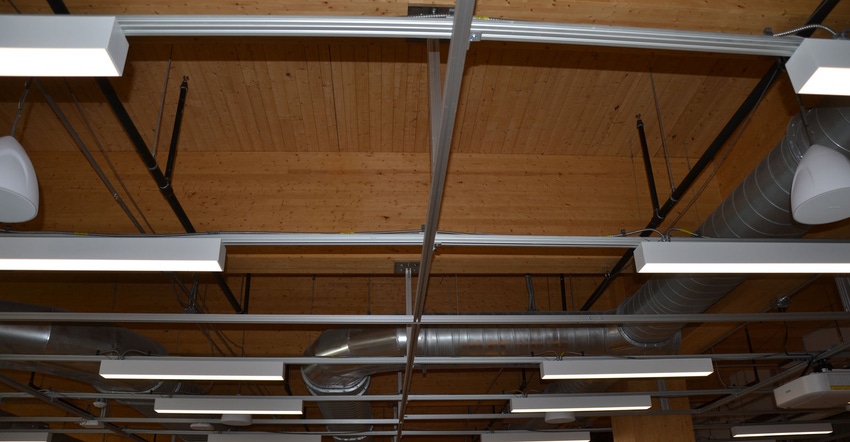March 30, 2022

Michigan State University recently garnered the WoodWorks Wood Design Award for Wood in Schools for using mass timber in its state-of-the-art STEM Teaching and Learning Facility.
The new STEM Teaching and Learning Facility features an abundance of natural light, exposed ceilings, and a mix of modern and repurposed architecture — including a mass timber and steel structural system. Tucked inside the sustainable building are spaces for students to collaborate and learn.
The STEM Teaching and Learning Facility is Michigan’s first mass timber building. Mass timber is an umbrella term for a variety of panelized, engineered wood building materials such as large cross-laminated timber (CLT) panels and glue-laminated (glulam) columns and beams with an array of structural and decorative uses in buildings.
“Humans have been building with wood for centuries,” says Sandra Lupien, director, MassTimber@MSU. “But not with wood like this. By creating super-strong panels and beams from layers of dimensional wood, we can build bigger and higher than ever with timber. And that’s a good thing — wood is a renewable resource and building with it has many sustainability benefits.
“Mass timber emits comparatively less carbon dioxide during production than many common building materials, and it stores carbon absorbed by trees while they’re in use in the building, keeping that carbon from releasing into the atmosphere where it would contribute to climate change.”
The 105,000 cubic feet of mass timber in the MSU STEM facility store a volume of carbon equivalent to not driving the average vehicle at least 4.7 million miles or not burning at least 2 million pounds of coal. The mass timber comprises Forest Stewardship Council black spruce from northern Quebec in Canada, and with sustainable forestry practices, North American forests can replace the volume of wood used in the building in only 8 minutes.
Integrated Design Solutions, along with Ellenzweig, Michigan State University, WoodWorks and an array of stakeholders, worked to make MSU’s vision for the state’s first mass timber building a reality.
Using cross-laminated timber
“The vision for a wood structure was championed by the entire team, especially Michigan State University and was not without risk,” says IDS’ Kevin S. Marshall, the project architect for the MSU STEM facility. “As the first structure in the state to utilize CLT, we were breaking new ground. But by exposing as much of the timber as possible along with careful design of the building systems, the team was able to put ‘science on display’ for the roughly 7,000 students who take classes in the building every week.
“The conversion of the long-decommissioned power plant gave the design team a way to create a hub of activity in the center of the complex and brought the wonderful structure out of hibernation. The deliberate mix of new and old throughout the complex creates a seamless unity celebrating the University’s STEM curriculum.”
This process led to categorizing the building as a Type IIIB construction, using a hybrid mass timber and steel structural system as well as a steel exoskeleton to support the brick, cast stone and glass to fit MSU’s campuswide aesthetic.
Seeking to ensure high visibility for the first new MSU building in decades exclusively to classrooms and laboratories, MSU opted to renovate the decommissioned Shaw Lane Power Plant located next to Spartan Stadium. The project team advanced a design that would be open, inviting and inspirational to emphasize the leading-edge teaching pedagogies that would be housed there. The building complex consists of 121,290 square feet of new construction split across north and south wings built around the original 48,531 square-foot, power-plant structure.
The finishes in the new construction consist of the mass timber — glulam columns and beams, CLT floor decks, and CLT wall panels in the stair towers — combined with polished concrete walking surfaces, glass and gypsum board creating a warm yet industrial aesthetic.
The power plant was carefully renovated to preserve as many items from the original building as possible while interweaving floor plates in the four-story volume. Since the power plant is a structural steel-framed, mass wall masonry structure, the renovated center section consists of steel beams connected to existing steel columns. New floor surfaces in that section use the same CLT structural floor decks, which are topped with a natural maple wood floor surface that maintains the original motif of the power plant while tying it to the modern mass timber.
The WoodWorks Award recognizes excellence and innovation in mass timber, heavy timber traditional wood-frame and hybrid buildings. A nonprofit dedicated to helping project teams design, engineer and construct successful wood buildings, WoodWorks has been hosting its award program for 15 years as a way to recognize developers and design teams whose creativity and emphasis on quality continue to expand the possibilities for wood buildings.
Source: MSU Extension, which is solely responsible for the information provided and is wholly owned by the source. Informa Business Media and all its subsidiaries are not responsible for any of the content contained in this information asset.
You May Also Like




